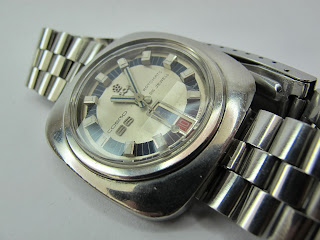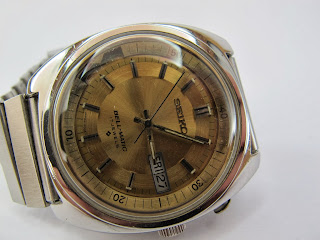Seiko Diver Turtle: 6309-7049
Back in April this year, I did a piece on Seiko diver 6309-7290 with the title:
May I have a can of Pepsi please? Today I would present to you the earlier version of Seiko diver 6309, the much sought after classic diver. The 6309-7040 and 6309-7049 are housed in big symmetrical cushion cases that protrude from either side of the bezel.
6309-7040, 6309-7049 (both with black bezels) and 6309-704X (with blue-and-red bezels) are essentially the same watch. The 7040 designation denotes watches intended for the Japanese home market and the rest of the world, while the 7049 designation was assigned to those watches intended for export to North America. 6309-7040 and 7049 were produced from 1976 until 1988.
These earlier 6309 diver variant comes in a large and thick stainless steel turtle case measuring approximately 44mm in width (48mm including the crown); 14mm in thickness; and 22mm in lug width. The case has a machined/satin finish and is composed of a combination of softly curved surfaces.
This cushion case also served as a crown guard. These watches have integrated threaded crown tubes which are intended to accommodate a thick telescoping screw-down type crown. The stainless steel crown is horizontally toothed (for ease of finger-grip) and unsigned.
All 6309 divers have mildly angled, 60-click, bi-directional, non-locking bezels. The bezel is with black-painted aluminum inserts, silver index markings and a recessed round lume dot. The bezel ring is bordered by two stacked rows of rectangular cut protrusions that aid with finger-grip during bezel turning.
The crystal should be a Seiko Hardlex mineral crystal. The original crystal supposed to be flat, have a frosted beveled edge, and should only protrude a little but never beyond the outer edge of the bezel.

The black matte dial is characterized by round hour markers at 1,2,4,5,7,8,10 & 11; Bell-shaped hour markers at 6 & 9; and a two-piece rounded triangular 12:00 marker that is divided by an inverted cross. At 3 O'clock position is the day and date function window. The day wheel is in dual language combinations, All hour markers are lumed.
The words SEIKO AUTOMATIC are written in whitish silver paint, directly below the 12:00 O'clock marker. The words WATER 150m RESIST. In early (1976 to approximately 1980) variants this text should be followed by the Suwa symbol, just above the 6:00 O'clock marker. This dial of mine is an aftermarket part. The original word’s WATER & RESIST were painted red, while the 150m was painted whitish silver paint. Between the 5 to 7 O'clock hour marker is tiny letters representing the dial codes secretly telling where the watch was made and cased.

This watch has bold silver hands. The hour and minute hands are well lumed to have better visibility underneath water. The second hand only has a lume dot near its outer end.
The stainless steel case-back is screw down type. Like all modern Seiko divers, it has a raised Seiko tsunami wave in the center. Deeply stamped at the caseback are the wordings: ST. STEEL 6309-7049, SEIKO, WATER RESIST, Japan A (indicating this is earlier batch between 1976 to 1980) followed by a Suwa logo. The six-digit serial number of this watch stated that this watch came out of its Japan factory on July 1977.
The 6309 diver are all powered by the 17 Jewels automatic caliber. This movement cannot be handwound and is non-hacking. It runs at 21,600 bph and has a quickset day/date calendar mechanism.
This watch of mine is using the Z22 strap from a more recent Seiko diver, the 7S26. Just for general information, the original silicone rubber strap should be marked "SEIKO GL-831 JAPAN".
The 6309 divers are probably the most popular dive watches ever! Its reputation for ruggedness (robust construction and highly reliable movement) and affordable price made the 6309 a popular choice. After almost 30 years since its last production, these watches are still highly sought after in second hand market places. In fact a large aftermarket has developed to support the restoration and modification of these watches. Seiko purists might hesitate and object to aftermarket, but a nicely restored, serviced and accurately timed 6309 justify everything.
Celebrities with a 6309 Turtle on hand.....
Ed Harris wore a 6309-704x in the 1989 movie "The Abyss."
Mick Jagger is wearing a 6309-704x in this 1983 photo.




















.jpg)








































